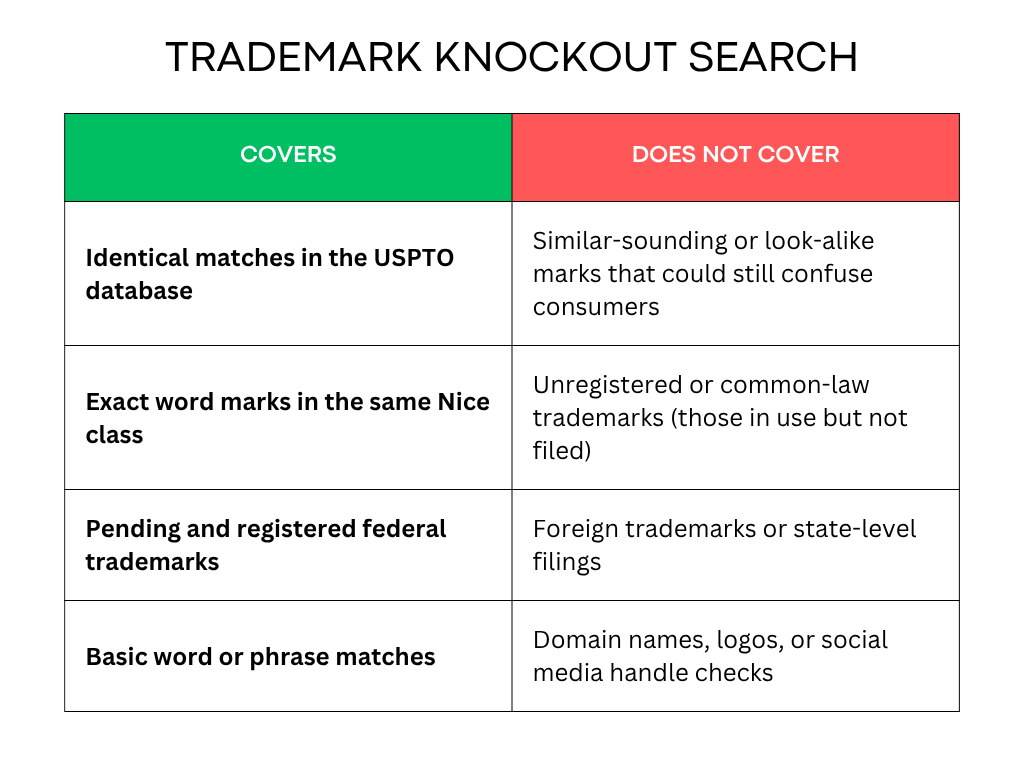Choosing a new brand name is an important decision — and not one to take lightly. Before committing to a name or logo, it’s essential to confirm that it doesn’t infringe on any existing trademarks. That’s where a trademark knockout search comes in. Acting as an initial screening step, it helps you quickly identify potential conflicts, saving you time, money, and future legal headaches by catching issues early in the branding process.
In this article, we’ll examine what a trademark knockout search is, how it’s different from a comprehensive trademark search, how you can do it, and why you should do a trademark knockout search before filing your trademark.
Table of Contents
ToggleWhat is a Trademark Knockout Search?
A trademark knockout search is a preliminary search of the United States Patent and Trademark Office (USPTO) database and, where applicable, international trademark records (e.g., WIPO Global Brand Database). Its purpose is to detect identical or highly similar trademarks that could cause confusion or block your application.
Leading trademark attorneys and IP professionals use this search as a cost-effective first filter before investing in full clearance searches or legal opinions. The knockout search focuses on clear, obvious conflicts rather than subtle or borderline cases.
How to Conduct a Trademark Knockout Search
A trademark knockout search can be done in two main ways — on your own using free government databases, or through professionals who offer faster and more accurate results. Which option you choose depends on how much risk you’re comfortable with and how critical the trademark is to your business.
DIY Knockout Search (Free Option)
If you’re just getting started or testing a few brand name ideas, you can perform a basic knockout search yourself using public trademark databases. Here’s how:
- Go to the USPTO TESS database
Visit TESS (Trademark Electronic Search System) — the official U.S. trademark search tool.
- Enter your proposed mark
Use the Basic Word Mark Search option for a straightforward check. Type your brand name exactly as you plan to use it — including spacing, punctuation, and capitalization.
- Select relevant Nice Classes
Trademarks are categorized into “Nice Classes” based on goods or services (e.g., clothing, food, software). Choose the classes that match what your business offers. This ensures you’re comparing your mark against the right competitors.
- Review search results carefully
Look for marks that are identical or nearly identical to yours. Pay attention to both live (active) and pending applications, as these could block your filing.
- Check the status and details
Each result shows whether the mark is live (registered or pending) or dead (abandoned or expired). Examine the owner details and classes to understand if there’s a conflict.
If you operate in Canada, use the CIPO Trademark Search database instead. For bilingual marks, search both English and French equivalents — for example, “Star Power” and “Puissance Étoile.”
While a DIY search is a great starting point, it’s not foolproof. Free tools usually identify exact matches, but they may miss marks that sound similar (like “BrightTech” vs. “BriteTek”) or appear in related industries.
Professional Knockout Search (Paid Option)
If your brand name is central to your business identity or you’re planning to file soon, a professional knockout search offers added security.
Trademark professionals and specialized search firms use a combination of AI-powered databases and manual attorney review to uncover risks that automated tools often overlook. This includes misspellings, phonetic variations, and marks with visual similarities.
A typical professional knockout report includes:
- Trademark details and ownership information
- Application and registration numbers
- Nice Class coverage and industry relevance
- Comments or recommendations from experts on whether to proceed or revise your mark
The process usually takes 24–48 hours, making it a quick yet reliable checkpoint before committing to filing fees. Many providers also offer consultation calls to help you interpret the results and plan your next step.
👉 Need help with a professional knockout search? Get a detailed report in as little as 24 hours and make your trademark filing decisions with confidence.
Why You Should Do a Knockout Search Before Filing
Early Identification of Potential Conflicts
An early knockout search reduces the risk of investing in branding that may later face legal challenges. Identifying conflicts at this stage allows for timely adjustments, avoiding wasted marketing and rebranding costs.
Mitigating Legal Risks and Associated Costs
Trademark infringement can lead to expensive litigation, cease-and-desist notices, and forced rebranding. While a knockout search cannot guarantee a trademark application’s success, it significantly lowers the risk of such disputes by addressing obvious conflicts early.
Efficient Use of Resources
By eliminating clearly conflicting names early, businesses save time and focus their efforts on names with higher chances of registration success.
Imagine a small café called Moonbeam Coffee filing for a trademark — only to later discover Moonbeam Café was already registered. A $350 filing fee is lost, plus the cost of rebranding and new materials.
What a Knockout Search Includes (and What It Doesn’t)
A trademark knockout search is designed to give you a quick, early-stage risk check before filing your application. It’s fast, affordable, and highly useful — but it’s also intentionally limited in scope. The goal is to identify any obvious conflicts that could block your application, not to provide a deep legal clearance.

Here’s a clear breakdown of what’s included and what isn’t:
What It Covers — In Detail
A knockout search focuses on federally registered trademarks and pending applications within the USPTO database. It checks whether your proposed name or phrase is identical or nearly identical to an existing mark in the same or related class of goods/services.
For example, if you’re considering the mark “Ocean Bliss” for skincare products, the search will flag any identical “Ocean Bliss” trademarks already registered or applied for under similar Nice Classes.
This level of search is ideal when you’re testing initial name ideas or want to ensure your chosen mark isn’t already taken at the federal level.
What It Doesn’t Cover — and Why It Matters
A knockout search won’t detect similar-sounding marks (like Ocean Blis or Oshun Bliss) or visual similarities in logos or stylized text. It also doesn’t include common-law marks, which are trademarks in use but not officially registered — these can still create legal risks if they’ve established market presence.
Likewise, it won’t reveal international filings, state-level registrations, or domain and social media usernames that may compete with your brand online.
Because of these limitations, many businesses follow up with a comprehensive trademark search before filing — a deeper analysis that includes phonetic, visual, and cross-jurisdictional comparisons.
Trademark Knockout Search vs. Other Trademark Searches
When defending your brand, all trademark searches are not created equal. One type of search, a trademark knockout search, is only for screening names at the early stages. Here’s how it differs from other trademark search types.
- Knockout Trademark Search: A quick, initial search of trademark registries (such as USPTO or WIPO) to identify likely conflicts. It is concerned with exact or highly similar marks. Suitable for initial brand name screening.
- Full Trademark Clearance Search: A more extensive review involving phonetic variations, translations, industry use, and common law marks. Usually carried out by attorneys or professional search agencies, it provides more in-depth analysis of possible risks.
- Trademark Watch Services: These are regular monitoring services that notify you when comparable marks are filed after your trademark registration. They assist you in shielding your brand from subsequent infringements.
- Legal Opinions: A trademark attorney can offer a formal opinion based on search findings. This is helpful to analyse the risk level and determine if one should go ahead with a filing.
When to Use Knockout Search vs. Other Types
A knockout search is best in the initial name-concept stage when you’re narrowing down possibilities and need to rapidly rule out obviously not available names. It’s quick, inexpensive, and saves you from spending on a name that will almost certainly be rejected.
But if you’re keen on a particular brand name, a comprehensive clearance search, and possibly a professional opinion, is the wiser choice. After you’ve registered your trademark, trademark watch services can assist you in protecting your rights in the long term.
How Much Does a Trademark Knockout Search Cost?
- DIY or automated tools: $20–$100
- Professional search with analysis: $75–$200
Turnaround time is typically 1–2 business days, depending on scope and coverage.
If you’re serious about protecting your brand, professional verification is often worth the small upfront cost.
Get A Free Trademark Search Sample Report
FAQ: Trademark Knockout Search
Is a knockout search required before filing?
No, but it’s strongly recommended to avoid rejection or disputes.
Can I do a knockout search myself?
Yes — USPTO’s TESS database is free. However, professional searches provide more accuracy.
What happens if I skip this step?
You risk losing filing fees or facing opposition from existing trademark owners.
What’s the difference between a knockout and comprehensive search?
A knockout search checks for identical matches; a comprehensive search finds similar, phonetic, or visual conflicts across multiple databases.
How reliable are free online searches?
They’re a good start, but not always exhaustive — especially for common or multi-word marks.
Conclusion
A trademark knockout search is a good, strategic start to the brand development process. Although it does not take the place of a comprehensive trademark clearance search, it functions as a crucial filter, getting you out of the way of obvious legal obstacles before you put a lot of time and money into a name.




